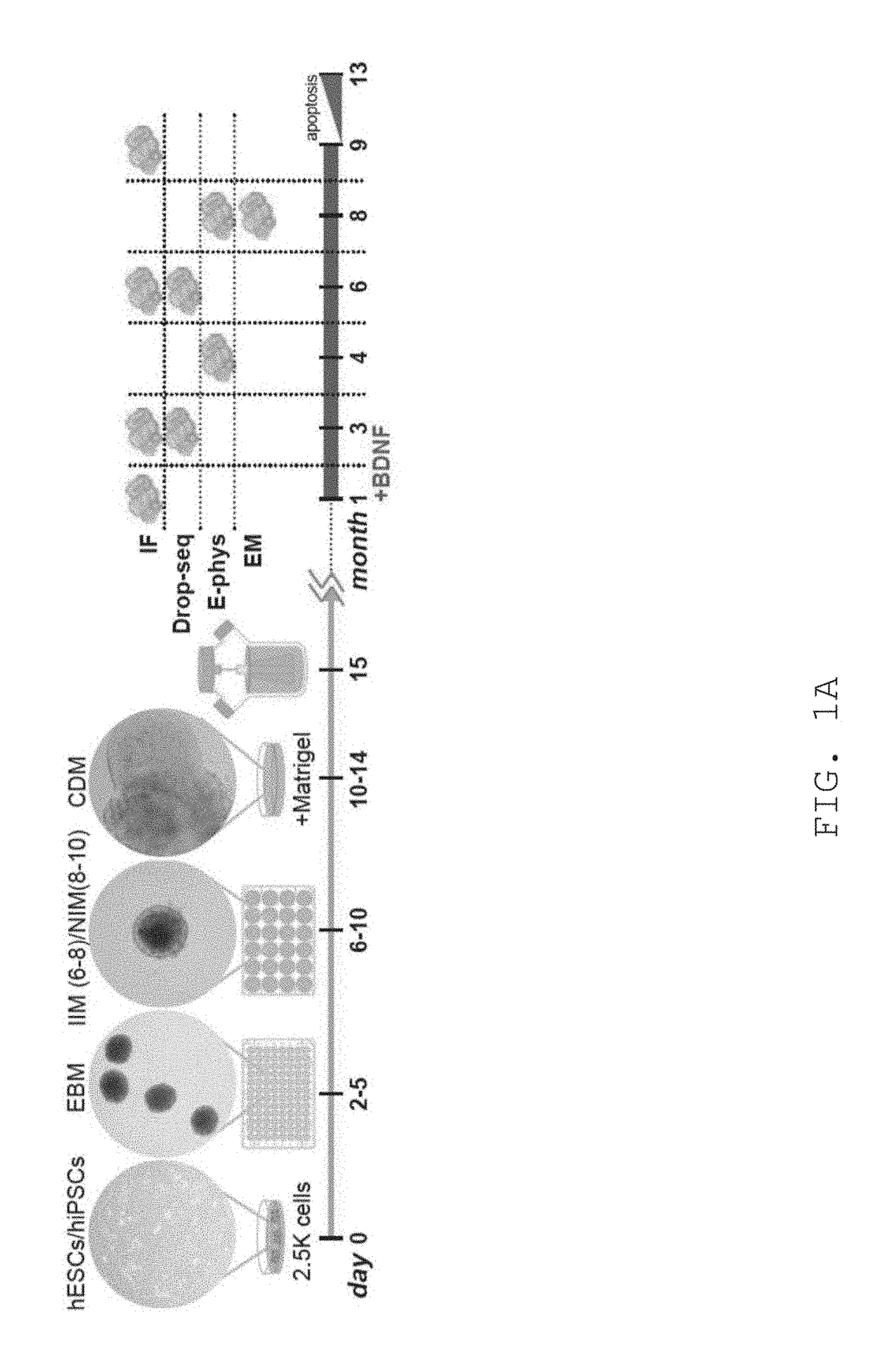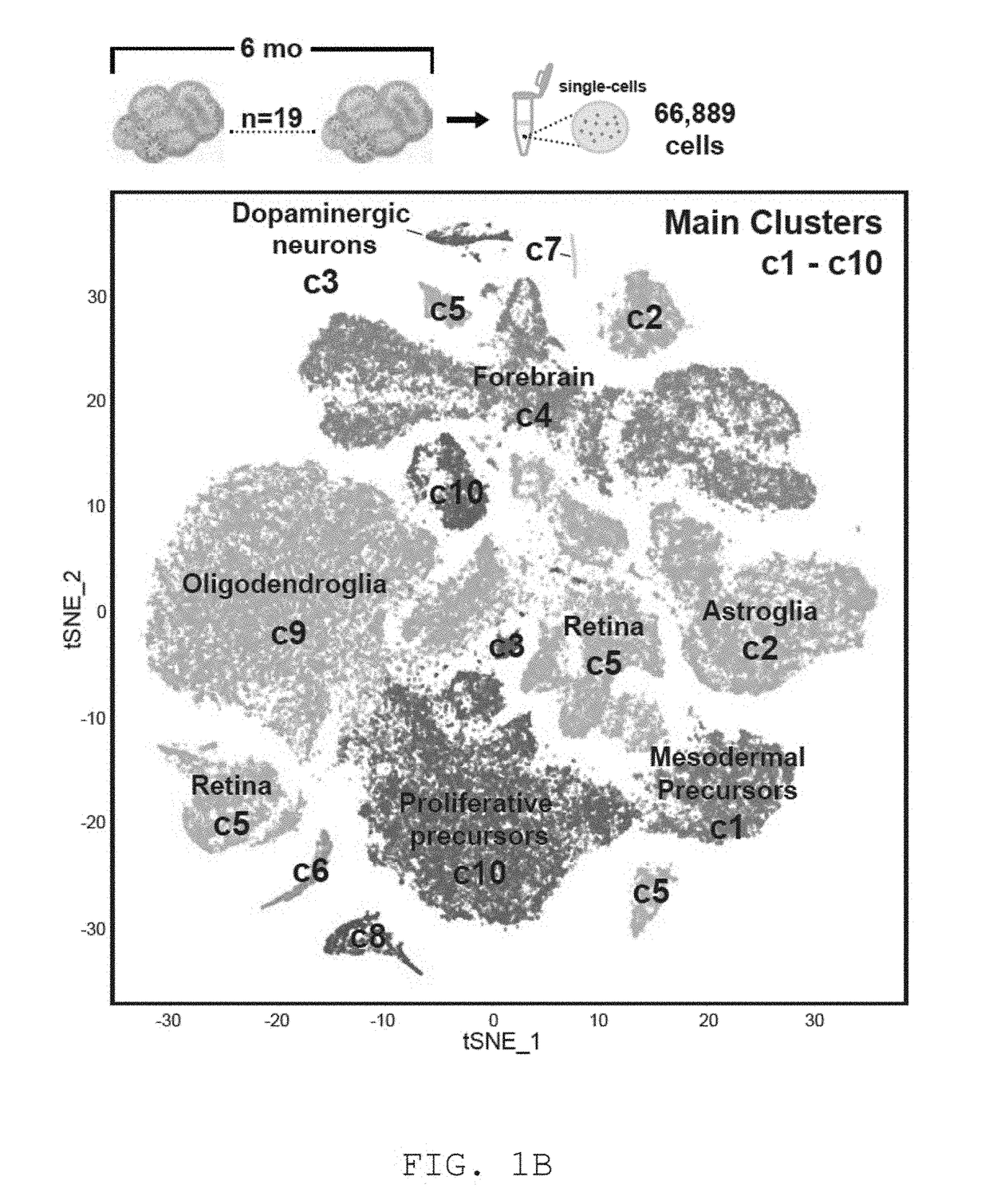Methods for generating neural tissue and uses thereof
a neural tissue and neural tissue technology, applied in the field of neural tissue generation methods, can solve the problems of limited studies using human and primate brain tissue, inherent differences in the development, architecture and function of the rodent brain, and incomplete understanding of the cellular composition of brain organoids
- Summary
- Abstract
- Description
- Claims
- Application Information
AI Technical Summary
Benefits of technology
Problems solved by technology
Method used
Image
Examples
example 1
Protracted In Vitro Development of Human Whole-Brain Organoids
[0199]Human whole-brain organoids are largely self-patterning systems and therefore in principle have the potential to generate the vast cellular diversity of the endogenous developing human brain. However, this possibility remains largely untested. To address this point directly, we have developed a modified version of the culturing protocol first described by Lancaster et al.2 to foster extended periods of growth and development in vitro and to favor the progressive generation of many cell types. Reducing the number of pluripotent stem cells used in initial EB seeding (2,500 cells), an enhanced neural induction paradigm, and addition of BDNF to the final differentiation medium have allowed us to successfully prolong the culture period, limiting premature cell death and enabling long-term, progressive development for 9-13 months (FIG. 1A, FIG. 5; see Methods for detailed protocol). With this protocol, the percentage of e...
example 2
Large-Scale, single-Cell Sequencing in Human Brain Organoids Reveals Extensive Diversity of Cells Resembling Known Endogenous Classes
[0201]Although single-marker analysis is valuable for gaining a global picture of the sequential generation of broad classes of cells and their geographic organization, individual markers cannot resolve the cellular diversity of the human brain, in which closely related sub-classes of cells can be identified only using combinatorial gene signatures. It also does not allow the identification of cell populations not expected a priori. Single-cell RNA sequencing allows systematic interrogation of many genes, but the unparalleled cellular diversity of the human brain requires that very large numbers of cells be profiled. To address this issue directly, we employed Drop-seq single-cell mRNA sequencing9 to molecularly profile 82,291 single cells isolated from 31 organoids derived from a healthy-control pluripotent stem cell line (iPSC line 11a; see Methods)....
example 3
Protracted Culture of Human Brain Organoids Leads to Increased Cell Diversity and Advanced Neuronal Maturation
[0209]In order to understand whether there is a progressive generation of cell types and possibly distinct maturation states over time in culture, we performed Drop-seq analysis on an additional 15,402 single cells from organoids at 3 months (n=12 organoids from 2 flasks) derived from the same pluripotent stem cell line (iPSC11a). We found that while some clusters of cells were present at both 3 and 6 months, older organoids contained additional clusters not present at 3 months (data not shown). This indicates that over the additional 3 months in culture, organoids not only survived but also continued to develop, generating new cell types.
[0210]To investigate whether long-term culture also allows greater cell maturation, we identified populations of cells that were present at both 3 and 6 months and compared their molecular signatures between ages. First, we examined cells i...
PUM
| Property | Measurement | Unit |
|---|---|---|
| time lag | aaaaa | aaaaa |
| molecular weight | aaaaa | aaaaa |
| density | aaaaa | aaaaa |
Abstract
Description
Claims
Application Information
 Login to View More
Login to View More - R&D
- Intellectual Property
- Life Sciences
- Materials
- Tech Scout
- Unparalleled Data Quality
- Higher Quality Content
- 60% Fewer Hallucinations
Browse by: Latest US Patents, China's latest patents, Technical Efficacy Thesaurus, Application Domain, Technology Topic, Popular Technical Reports.
© 2025 PatSnap. All rights reserved.Legal|Privacy policy|Modern Slavery Act Transparency Statement|Sitemap|About US| Contact US: help@patsnap.com



